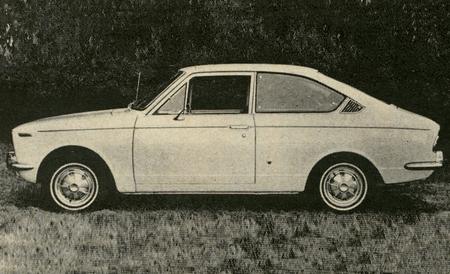Drum brakes are used all around on the Corolla; two leading shoes in front and leading and trailing shoes in the rear. Pedal pressure is reasonable and no significant fade was noticeable in four stops from 70 mph. However, the stopping distances of 241 feet (0.68G) are longer than what we would consider acceptable. Just because the Corolla is a low powered car we see no reason why it shouldn’t stop quickly. Any car that can’t stop at a minimum rate of 0.7G is lagging behind the current state of the art in brake system development.
In an automobile with an overall width of less than five feet, it hardly seems necessary to comment on the accessibility of the controls. To be out of reach they’d have to be located somewhere in the trunk. Still, the driving position in the Corolla seems particularly well laid out. It’s snug, to be sure, but the uniform snugness obviously didn’t just happen. The instrument panel is efficient and somehow cheery. In layout it’s very similar to a Camaro with the instruments directly in front of the driver and the radio, heater controls and miscellaneous small controls in the center. To the left of the panel are ignition and headlight switches. The instrumentation consists of two large round dials: a speedometer on the right and what Toyota calls a combination meter on the left. Combination meter is as good a name as any for a gauge that tells you everything else that’s happening: fuel level, engine temperature and warning lights for oil pressure and the electrical system. Everything is properly labeled and easily readable in sharp contrast to typical imported car practice. Our only criticism is that the lenses on the two dials reflect light that enters through the rear window.
Aside from lack of head room, the Sprinter differs from the 2-door sedan only in the seats. Since the Sprinter costs $130 more than the sedan you would expect plusher seats and you won’t be disappointed. The Sprinter is very easy on your backside, although the extra thickness of the cushions doesn’t help the interior space problem. Fully reclining front buckets are standard on both the sedan and the fastback. The Sprinter’s rear seat is truly a masterpiece of space utilization. Since the cushion is very low, your thighs quite naturally incline upward at a pretty steep angle, but there is enough thigh support so that this is in no way uncomfortable. The big surprise is that your legs can point directly forward because the front seatback has been contoured to clear your knees. Not only is the interior well designed but it’s also well finished right down to the carpet that’s perfectly molded to the shape of the floor with every edge carefully bound to avoid that low-priced look.
Careful use of space is apparent in the trunk too. The spare tire is stored below floor level leaving space for several large suitcases and a few small things besides.
It’s pretty obvious that some very sound basic thinking went into the Corolla to provide a useful car in a small package. The result is that Toyota owners will not be burdened by annoyances other imported cars impose. Take the Corolla’s use of one of Ford’s Better Ideas for example. The keys are reversible so you never have to wonder which side is up. Unlike some other cars in the class there is also a separate trunk key—but the trunk key also operates the ignition and door locks so you never select the wrong key for those two tasks. A simple and obvious idea to eliminate confusion that we all grumble about and yet no one else, not even Ford, thought of it.
At $1796 the Corolla Sprinter is an attractive automobile if your size (and its) permits, and if you’re not irrational about headroom. If you are irrational about headroom there is always the 2-door sedan for $1666 which isn’t a bad alternative. Of course the price is really just a little higher because the importer, being a shrewd businessman, knows that the Corolla will move at a higher price so they’re all being brought into the country with the optional tinted glass, whitewall tires and anti-freeze, for which you must pay extra. Even so, the price on our test Sprinter, which included a radio and dealer preparation, was only $1965.
We find only one looming inconsistency in the Sprinter’s concept. We can’t accept the idea that a sports car results from simply grafting a fastback on to a sedan. Plymouth tried it without much success, and—except for the intrigue of Toyota’s foreign accent—there is no reason for the Corolla to fare any better.
No car is perfect, we keep hearing, particularly at this price. Weigh the Corolla’s advantages against its disadvantages and you’ll find it a tough contender in the econo-sedan business.


Leave a Reply